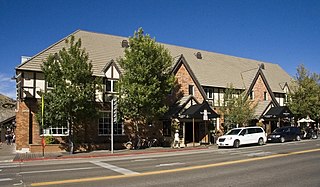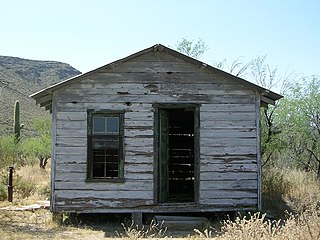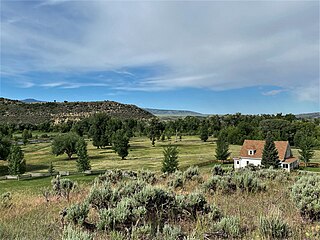
The Wolfe Ranch, also known as Turnbow Cabin, is located in Arches National Park near Moab, Utah, United States.

The 4 Lazy F Ranch, also known as the Sun Star Ranch, is a dude ranch and summer residence in Jackson Hole, Wyoming, built by the William Frew family of Pittsburgh in 1927. The existing property was built as a family retreat, not as a cattle ranch, in a rustic style of construction using logs and board-and-batten techniques. The historic district includes seven cabins, a lodge, barn corral and smaller buildings on the west bank of the Snake River north of Moose, Wyoming. The property was added to the National Register of Historic Places in 1990.

The Bar B C Dude Ranch was established near Moose, Wyoming in 1912 as a dude ranch by Struthers Burt and Dr. Horace Carncross, using their initials as the brand. Rather than converting a working ranch, Burt and Carncross built a tourist-oriented dude ranch from the ground up, using a style called "Dude Ranch Vernacular", which featured log construction and rustic detailing. As one of the first dude ranches in Jackson Hole, the Bar B C was a strong influence on other dude ranches in the area, and employed a number of people who went on to establish their own operations. It was acquired by the National Park Service and incorporated into Grand Teton National Park upon the expiration of a life estate. The ranch was listed on the National Register of Historic Places in 1990.

The Wort Hotel was built in downtown Jackson, Wyoming, United States by brothers John and Jess Wort, who were significant figures in the transformation of the economy of Jackson Hole from ranching to tourism. The somewhat Tudor-style building was the first luxury hotel in Jackson. The two-story building features brick facing, with half-timbering and stucco on the second floor and a series of gables facing the street.

The Manges Cabin in Grand Teton National Park, also known as the Old Elbo Ranch Homestead Cabin, Mangus Cabin and the Taggart Creek Barn, was built in 1911 by James Manges. Manges was the second settler on the west side of the Snake River after Bill Menor, setting up a homestead near Taggart Creek. James Manges arrived in Jackson Hole in 1910, where he cut wood for Charles or William Wort. Manges' cabin is stated to have been the first two-story structure in the northern part of the valley. A root cellar was excavated beneath. The log and frame structure features wide eaves to keep the winter snow away from the walls. It was heated in winter by a single stove, with one room on each level.

The White Grass Dude Ranch is located in the White Grass Valley of Grand Teton National Park. The rustic log lodge, dining hall service building and ten cabins were built when a working ranch was converted to a dude ranch, and represented one of the first dude ranch operations in Jackson Hole. The White Grass was established in 1913 by Harold Hammond and George Tucker Bispham, who combined two adjacent ranches or 160 acres (65 ha) each, and was converted to a dude ranch in 1919. Bispham had worked at the Bar B C before moving out on his own. The dude ranch operation continued to 1985, when the ranch was acquired by the National Park Service.

The Hunter Hereford Ranch was first homesteaded in 1909 by James Williams in the eastern portion of Jackson Hole, in what would become Grand Teton National Park. By the 1940s it was developed as a hobby ranch by William and Eileen Hunter and their foreman John Anderson. With its rustic log buildings it was used as the shooting location for the movie The Wild Country, while one structure with a stone fireplace was used in the 1963 movie Spencer's Mountain. The ranch is located on the extreme eastern edge of Jackson Hole under Shadow Mountain. It is unusual in having some areas of sagebrush-free pasture.

The Faraway Ranch Historic District is part of the Chiricahua National Monument in southeastern Arizona, and preserves an area associated with the final conflicts with the local Apache, one of the last frontier settlements, and in particular, its association with the people who promoted the establishment of the Chiricahua National Monument. Faraway Ranch is located in Bonita Canyon, which lies at an approximate altitude of 5160 feet and opens in a southwesterly direction into the Sulphur Springs Valley.

The Bates Well Ranch, also known as the Bates Well, Growler Well, Gray Ranch and El Veit, was one of the fifteen ranches and line camps in the Gray family cattle business in the Sonoran Desert country north of the US-Mexico border in Pima County, Arizona. Operating for nearly 60 years, the ranch is now part of Organ Pipe Cactus National Monument.

The Rial Chew Ranch Historic District comprises a ranching operation in what is now Dinosaur National Monument in northwestern Colorado, that existed from 1900 to 1949. The Rial Chew family established the ranch in 1900, operating it as a park inholding after the national monument was established in 1919. The district includes a house, a cabin, root cellar, corrals and several storage buildings. The cabin may have been built at Blue Mountain by Harry Chew, and moved to the present site by Jack Chew, Rial's father. The ranch was occupied by the Chew family until their special use permit expired in the early 1970s.

The Kirk's Cabin Complex was built by homesteader Rensselaer Lee Kirk circa 1890 in what would become Canyonlands National Park in Utah. Kirk was a small rancher who built a log cabin and two corrals at the location, but was unable to make a living there and abandoned the ranch after a few years. Since that time the location was used by cowboys whose herds were grazing in the area, until the late 1960s when the national park was established.

The historical buildings and structures of Grand Teton National Park include a variety of buildings and built remains that pre-date the establishment of Grand Teton National Park, together with facilities built by the National Park Service to serve park visitors. Many of these places and structures have been placed on the National Register of Historic Places. The pre-Park Service structures include homestead cabins from the earliest settlement of Jackson Hole, working ranches that once covered the valley floor, and dude ranches or guest ranches that catered to the tourist trade that grew up in the 1920s and 1930s, before the park was expanded to encompass nearly all of Jackson Hole. Many of these were incorporated into the park to serve as Park Service personnel housing, or were razed to restore the landscape to a natural appearance. Others continued to function as inholdings under a life estate in which their former owners could continue to use and occupy the property until their death. Other buildings, built in the mountains after the initial establishment of the park in 1929, or in the valley after the park was expanded in 1950, were built by the Park Service to serve park visitors, frequently employing the National Park Service Rustic style of design.

Cedarvale, also known as Hillsboro Ranch, was a dude ranch and working ranch in Carbon County, southern Montana, United States. The ranch was established about 1903 by prospector Grosvener W. Barry on the South Fork Trail Creek. Barry used the ranch as a home for his family and as a base for his mining ventures, all of which failed. His most lucrative venture was the conversion of Cedarvale from a working ranch to a dude ranch, marketed through an arrangement with the Chicago, Burlington and Quincy Railroad. It was the first dude ranch in the area. Barry introduced powered boats to the Bighorn River to carry dudes to the ranch from the railhead at Kane, Wyoming. As a publicity stunt Barry, his stepson and a neighbor piloted the 16-foot (4.9 m) motorized Edith from the Hillsboro landing down the Bighorn, Yellowstone, Missouri and Mississippi rivers, leaving on May 31, 1913 and arriving in New Orleans on August 1. One of Barry's boats, the Hillmont, is on display at Barry's Landing.

Peaceful Valley Ranch is about 3 miles (4.8 km) from the town of Medora, North Dakota in the South Unit of Theodore Roosevelt National Park, in western North Dakota. The ranch dates from 1885, when Benjamin Lamb bought the land and built its first buildings. After operating as a ranch, primarily raising horses, the ranch was developed by the Olsen family as a dude ranch before it was acquired by the National Park Service, and incorporated into the Roosevelt Recreation Demonstration Area, which eventually became the present national park. The ranch forms the core of the national park's South Unit. It overlooks the Little Missouri River, in the Little Missouri badlands.

The N.K. Boswell Ranch is one of the oldest ranches on the edge of the Laramie Plains along the Big Laramie River in Albany County, Wyoming, USA. The ranch was established in the early 1870s, possibly by a man named C.T. Waldron. The ranch is significant for its association with Nathaniel K. Boswell, who was Albany County Sheriff at a time when the county extended from Colorado to Montana.

The San Rafael Ranch, formerly known as the Greene Ranch, is a historic cattle ranch located in the San Rafael Valley about a mile and a half north of Lochiel, Arizona, near the international border with Sonora, Mexico.

The Stone Wall Ranch, also known as the Reader or Rasmussen Ranch, is a ranch in the Little Snake River valley of Carbon County, Wyoming, about 1.5 miles (2.4 km) from Savery. It was established by Noah and Hosannah Reader in 1871, the first permanent homestead in the valley. A temporary winter shelter was built in the winter of 1871-72, followed by a permanent structure in 1872-73 that survives in the ranch complex. The ranch was named for a nearby sandstone escarpment.
The CM Ranch and Simpson Lake Cabins are separate components of a single historic district associated with Charles Cornell Moore, a Fremont County, Wyoming dude ranch operator. The CM ranch, named after Moore, operated as a dude ranch from 1920 to 1942 and resumed operating in 1945. The Simpson Lake Cabins were purchased by Moore in 1931 and were operated as a hunting camp, continuing until 1997 when the CM ranch was sold to new owners and the Simpson Lake property was taken over by the U.S. Forest Service.. The sites are separated by 13 miles (21 km).
The Dorr Ranch was established by William and Mabel Dorr in 1910 in Converse County, Wyoming along Woody Creek. William had left home at the age of 8 or 9 and worked for the 71 Quarter Ranch and as a horse wrangler at Pony Express stations in Wyoming. He met Mabel McIntosh and married her in 1904. Mabel's parents had established the successful Hat Ranch near Split Rock and had significant resources to assist the young couple. The Dorrs filed for their first homestead in 1910 and expanded it in 1915, and again in 1917 and 1919, with a separate 1919 filing by Mabel. The Dorr's properties were not contiguous, and the present ranch house on Woody Creek was not built until 1915. In 1919 the Dorr School was built on the ranch. The same year the community of Bill was established, named after the shared name of four of the founders. The main ranch house was built in 1926–27.



















